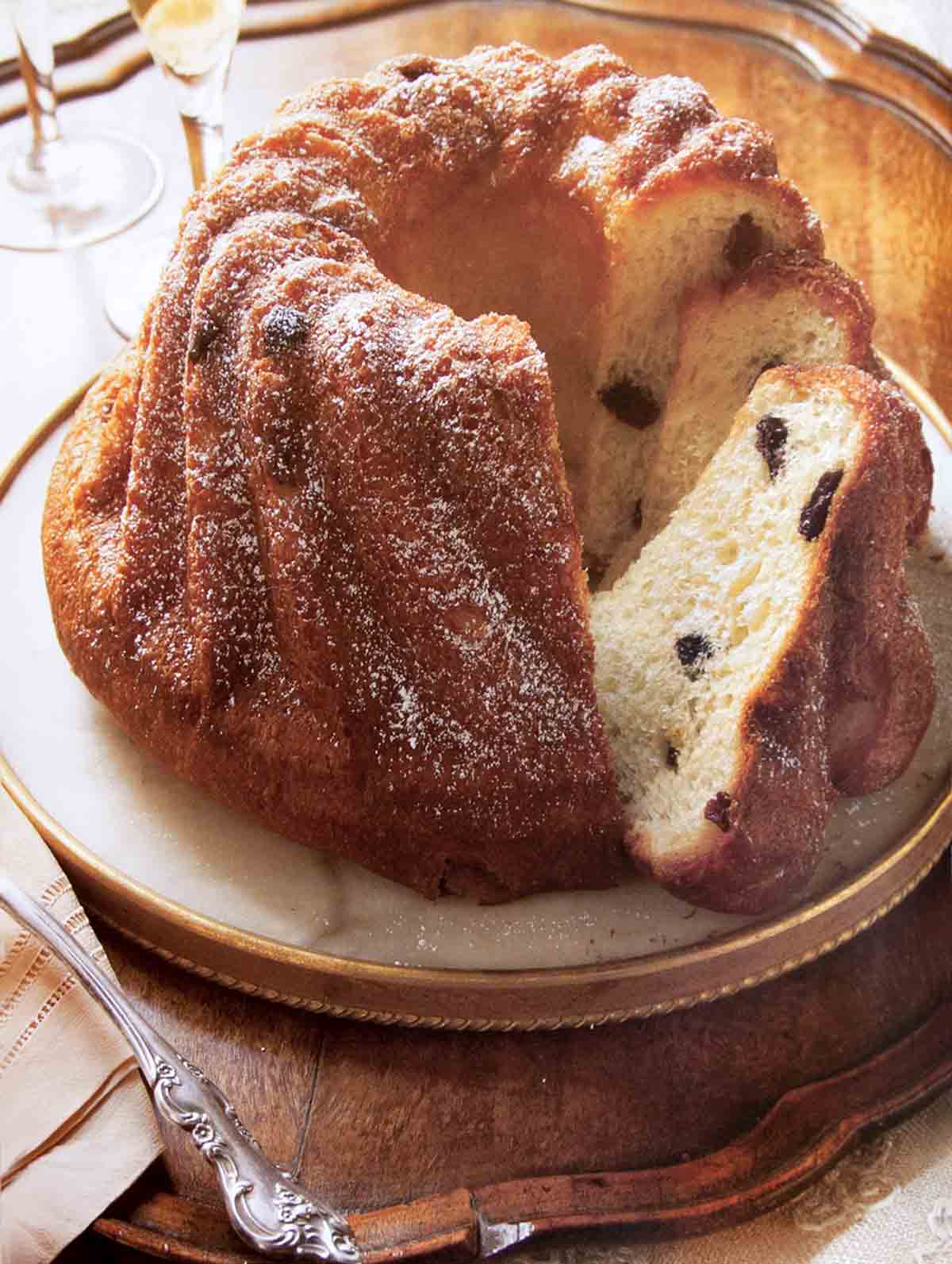
Contents
For anyone who comes from Alsace, the northeastern region of France, kugelhopf, as plain as it is, is a dream food. Part bread, part cake, kugelhopf is made very much like brioche. In fact, it is almost a brioche, but not a rich one. You won’t miss the bit of butter that’s left out of the dough, though, because once it’s baked, the cake is soaked with melted butter and sprinkled with sugar, so it develops a fine crust. While, in a pinch, you could make a kugelhopf in a Bundt pan, it’s a treat to make it in the pan designed especially for it. Sometimes called a Turk’s head or “turban,” a kugelhopf pan is fairly slender and has graceful curves (which do, in fact, resemble the wrap of a turban). If you want to be completely authentic, you can look for a heavy pottery kugelhopf mold from Alsace — you might even find one with painted flowers. Or you can use a silicone turban pan, as I do. It gives me particular pleasure to bake a centuries-old recipe in something so modern. Like brioche, this dough is best made using a heavy-duty mixer; however, you can succeed in mixing it in a large bowl with a wooden spoon.–Dorie Greenspan
HOW SHOULD I STORE MY KUGELHOPF?
Kugelhopf stales quickly. So if you’re not going to serve the kugelhopf as soon as it cools, wrap it in plastic without sprinkling it with confectioners’ sugar. Then sprinkle it with the sugar before serving. If you don’t make it through the loaf quickly enough, rest assured, stale kugelhopf is delicious cut into thick slices, toasted, and spread with butter and marmalade.
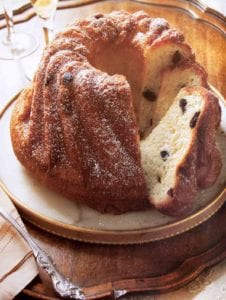
Kugelhopf
Equipment
- 9-inch kugelhopf mold (8- to 9-cup capacity)
Ingredients
For the cake
- 1/3 cup moist, plump raisins
- Scant 1 1/2 teaspoons active dry yeast
- 1/3 cup just-warm-to-the-touch whole milk
- 1 2/3 cups all-purpose flour
- 1/4 teaspoon salt
- 2 large eggs
- 1 large egg yolk
- 3 tablespoons granulated sugar
- 1 stick (4 oz) unsalted butter, at room temperature
For the soak
- 4 tablespoons (2 oz) unsalted butter
- Granulated sugar, for dusting
- Confectioners’ sugar, for dusting
Instructions
Make the cake
- Bring a little water to a boil in a small saucepan and toss in the raisins. Turn off the heat and let steep for 2 minutes, then drain the raisins and pat them dry.
- Put the yeast and milk in the bowl of a stand mixer and, using a wooden spoon, stir until the yeast is dissolved. Add the flour and salt and stir just to moisten the flour—don’t be concerned, the mixture will be shaggy and there may be dry patches.
- In a small bowl, beat the eggs and yolk together lightly with a fork. Fit the mixer with the dough hook, if you have one, and, working on low speed, pour in the beaten eggs, mixing until they are incorporated. Add the sugar, increase the mixer speed to medium-high, and beat until the dough comes together and smoothes out a little, about 5 minutes. Reduce the mixer speed to medium and add the butter in 4 to 6 additions, squeezing each piece to soften it before adding it and beating until each one is almost fully incorporated before adding the next. This will take some time-just keep at it.
- When the butter is blended in, the dough will be very soft. Increase the mixer speed to medium-high and beat, scraping down the sides and bottom of the bowl as needed, until the dough pulls away from the sides of the bowl and climbs up the hook, about 10 minutes. Remove the bowl from the mixer and stir in the raisins. Scrape the dough into a clean bowl, cover with plastic wrap, and let rise in a warm place until nearly doubled in size, about 2 hours. (The length of time will depend on the warmth of your room.)
- Deflate the dough by lifting it up around the edges and letting it fall back with a slap into the bowl. Cover the bowl again and put it in the refrigerator. Slap the dough down in the bowl every 30 minutes until it stops rising, 2 to 2 1/2 hours. Then, if you have the time, let the dough rest in the refrigerator overnight. (The dough can be wrapped tightly and refrigerated for up to 2 days.)
- Generously butter a 9-inch kugelhopf mold (8-to-9-cup capacity) and put the chilled dough in the pan. Cover the pan lightly with buttered parchment or wax paper and let the dough rise in a warm place until it comes almost to the top of the mold, 3 to 4 hours.
- When the dough has almost fully risen, center a rack in the oven and preheat the oven to 375°F (190°C).
- Remove the paper and bake the kugelhopf for 10 minutes. Cover the pan loosely with a foil tent and bake for another 15 to 20 minutes, or until the kugelhopf is golden brown and has risen to the top — or, more likely, over the top — of the pan. Meanwhile, line a baking sheet with foil and place a rack over it. Remove the kugelhopf from the oven and unmold it on the rack.
Soak the cake
- Melt the butter and gently brush the hot cake with it, allowing the butter to soak into the cake. Sprinkle the hot cake lightly with sugar and cool it to room temperature.
- Right before serving, dust the kugelhopf with confectioners' sugar.
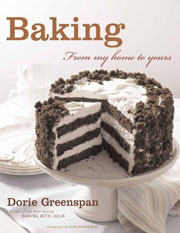
Nutrition
Nutrition information is automatically calculated, so should only be used as an approximation.
Recipe Testers’ Reviews
I love baking with yeast. I love bread. I love enriched dough. And the few yeasted cakes I’ve made, I’ve also loved. So I leapt at the chance to make this kugelhopf. I wasn’t sure what to expect, as the only kugelhopf I’d seen was on Great British Bake Off and I’d never tasted one. But I figured, why not?
The instructions were clear and easy to follow. And everything came together exactly as it was supposed to. With the exception of things taking a bit longer to rise because my house is cold, there was nothing that didn’t happen precisely as the recipe stated it would. The timing was 100% accurate on everything with the exception of rise times, as I mentioned above. I let the dough rest in the fridge overnight as recommended. It rose beautifully when baked. The texture was divine! This isn’t a super sweet dessert but it is flawless in its simplicity.
Fun fact, whenever I try a new recipe, I follow up by going through my tried and true cookbooks, finding a comparable recipe and make that to see if there is room for improvement. The first cookbook I opened of mine, happened to be this exact recipe! (Dorie Greenspan is one of my culinary obsessions.) So it was no surprise that this recipe is nearly perfect! I gave it a 9/10. But really, it should just be a ten.
I will absolutely be making this again. I love this recipe.
A very light, dry, and not-so-sweet traditional cake, which should be eaten on the same day. The addition of melted butter and sugar gives it some moisture, and a thin sweet crust on the surface that makes it even more appetizing.
And if you have leftovers, it’s delicious toasted and served with jam. With a very simple preparation, you should not give up trying this traditional recipe for the time it may take as it is well worth the result.
First, a confession—I don’t remember the last time I worked with yeast or made bread. I find bread intimidating and have avoided trying my hand…until now. This recipe has inspired me to be a little more adventurous, especially after feeling a huge sense of accomplishment when I finished. (As an aside, this is what I was hoping for when I requested to be a tester—test myself, learn, and grow more confident in my cooking skills. Yay!).
As for the recipe, I followed it exactly and it came out beautifully—a really soft, lightly sweet bread-y texture that almost melts in your mouth. I had borrowed a proper Kugelhopf mold from a friend married to an Austrian, so the finished product looked lovely and intricate. It was a time commitment, for sure, especially since I’m a bread novice and felt I needed to be focused on every step. From start to finish, it took me about 21 hours, including the overnight time to rest the dough. Real hands-on time was probably somewhere around 60-75 minutes, tops, over that time period, all in—and I could have shortened that time by a few hours by getting it out of the fridge sooner to start the baking process, but that’s just how my schedule worked out. The timings specified in the recipe were pretty close to mine with a couple of exceptions—After punching down the dough and putting it in the fridge after the first proof, it continued to rise beyond the 2 hours specified in the recipe. I punched it down, as the recipe suggested, about every 30 minutes or so, but after 2 1/2 hours it was still rising. I finally just wrapped it in plastic and let it be in the fridge. It rose a smidge more but that didn’t seem affect the outcome.
I was a little worried about humidity/temperature to ensure everything rose as expected, so I employed a trick I read in Cook’s Illustrated to help it along: I put a few cups of boiling water in a pan in the oven (turned off, of course) with the dough. That worked a charm—both times the dough rose quickly. In the second case (just before baking) it rose after about 1 hour 45 minutes, rather than 2 hours, as the recipe suggested.
Perhaps because my kugelhopf mold was already warm from being in the oven, my bake time was shorter. I only needed twenty minutes total—after 10 the crust was brown and at the top of the mold; after another 10 it was cooked through. Thanks for the opportunity to test this recipe. I learned a lot really enjoyed myself!
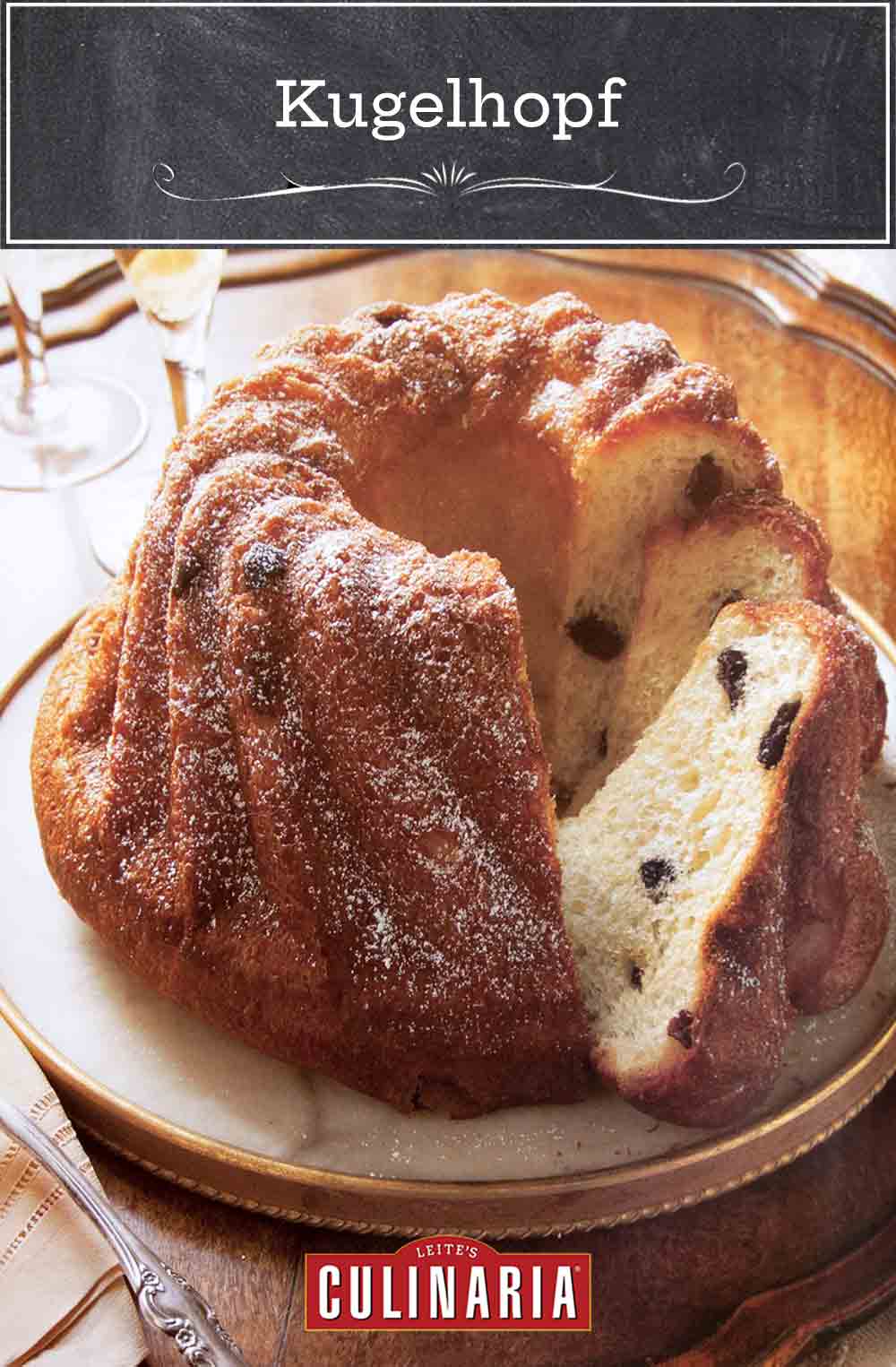


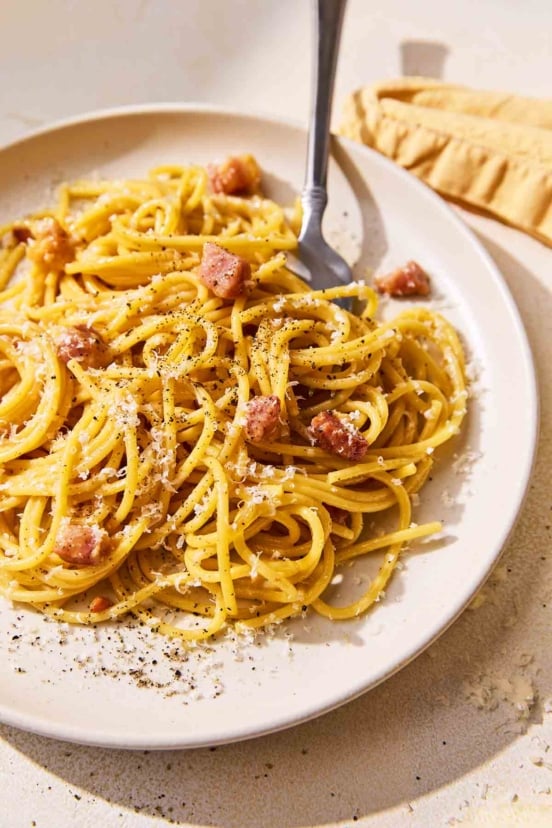

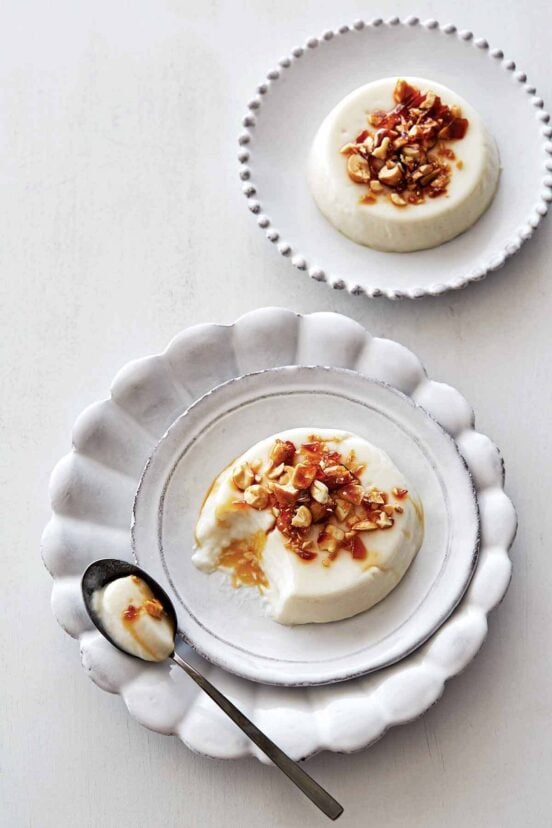









I was so glad you said you test your recipes over and over again. I ate Kugelhopf in Alsace France recently and wanted to replicate what I had. I followed your recipe with trepidation, but the final result was delicious! Thank you.
You’re welcome, Kathy! We are thrilled that they turned out so well. Thank you for taking the time to comment.
I was in Alsace, I saw all the lovely cakes and pastries in the bakery. It was the first time I was introduced to a Kugelhoph cake. It was delicious. We were so rushed to get back to the ship and I, so much wanted to buy the ceramic pan to try and bake this lovely cake.
I bought a Kugelhoph pan. I did print off this recipe and made this wonderful cake. It turned out so good. Nothing left to make toast. I have made this for my Xmas breakfast.
Thanks so much for this wonderful, delicious recipe. A keepsake.
Vally, you are more than welcome!
I am making this and having a problem with the dough, even though I used a scale to measure my ingredients…….it is extremely soft, like cake batter. I had to add 5 tbsp flour and even then it was quite soft. Any idea what went wrong?
Hi Lorraine, flour measurements can be so imprecise. What was your scaled weight for the flour?